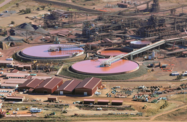Highly dependent on coal for its current electricity supply, and facing rising demand and supply gaps stemming from years of underinvestment in capacity expansion, South Africa is embarking on a plan to increase the contribution of gas, nuclear and renewables towards its national energy mix.
At present, coal accounts for around 85% of South Africa’s power generation. Given its abundance – with the country estimated to hold around 3.5% of global reserves – and its low cost, the easily sourced commodity will retain its prominence in the national power mix. Indeed, two massive new 4800-MW coal-fired plants are slated to start operations in the coming couple of years, which will provided much needed capacity but will do little to reduce the reliance on fossil fuels.
According to Dipuo Peters, the minister for energy, “We acknowledge that our energy mix is at the moment quite fossil intensive, but we are also very cognisant of the fact that we have one of the world’s largest coal reserves, and that it would be wrong for us as a country to not explore and implement emerging green coal technologies that would enable us to better exploit our coal with a reduction in associated greenhouse gas emissions.”
However, the country’s leadership acknowledges the necessity of shifting from coal-fired power stations towards more sustainable and cleaner sources of electricity generation, both for environmental and financial sustainability. To this end, the government’s Integrated Resource Plan (IRP), which provides a 20-year outlook for electricity generation through to 2030, aims to decrease coal’s share to 65%, with nuclear and other renewable technologies targeted to contribute 20 and 9%, respectively.
With South Africa ranked as the world’s 13th-largest emitter of greenhouse gas due to its intensive coal generation, the IRP is heavily prioritising the development of renewable resources, hoping to add 3725 MW of green energy to the national grid by 2016. Tenders for independent wind and solar projects are ongoing, with an estimated total investment of over $12.03bn.
In addition to investing in its own production capacity, the country also wants to be at the forefront of the green industry for Africa as a whole, seeking to become a leading manufacturer and supplier of wind and solar components.
According to Rob Davies, the minister of trade and industry, “The next wave of industrial activity around the world is linked to the environment and sustainability. We have identified the opportunity for creating 300,000 jobs in the ‘green economy’. In the last wave of global industrial activity, which was the ICT revolution, South Africa was used as a service provider for other countries’ technology and manufactured goods. This time around, we want to capture a share of the actual manufacturing, and produce energy-saving and generation technologies at home.”
Still, with renewables hampered by high generating costs and limited demand, there are moves afoot to source other potential domestic sources, including – controversially – shale gas. The country has vast reserves of recoverable shale gas, estimated to be some of the largest in the world, but the location of the deposits in an environmentally sensitive area, along with uncertainty over the effects of shale gas production, has prompted intense opposition, with the government imposing a moratorium on current activity. Should the moratorium, which is pending further studies on the environmental impact of tapping the reserves, ultimately be lifted, this cheaper and less carbon-intensive resource will surely factor strongly into the nation’s energy composition moving forward.
According to a 32-country survey undertaken by the US Energy Information Agency, South Africa, which produces no gas currently, has the fifth-largest volume of shale reserves at 485trn cu feet, most of which lies in the environmentally sensitive area of the Karoo Basin. Royal Dutch Shell, one of the frontrunners in shale exploitation, commissioned a study by Econometrix, a research firm, revealing that the development of a shale gas industry could create 700,000 jobs and contribute up to $24.05bn to GDP annually.
Shale gas is extracted through a controversial process called fracking, which involves blasting water mixed with sand and chemicals underground to free trapped hydrocarbons from shale formations. Opponents of the process claim it can cause water contamination and other environmental damage. In order to fully assess the economic and environmental implications, the government imposed a moratorium on new fracking licences and activity in 2011.
Also generating debate and opposition from environmental groups are proposed plans to produce 9600 MW of nuclear power for the national grid. While the government has not yet disclosed the amount to be committed towards the construction of nuclear plants, it is estimated that it could exceed $36.08bn.
A national nuclear energy executive committee, headed by Kgalema Motlanthe, the deputy president, was established in 2011 to oversee the procurement process. The Nuclear Industry Association of South Africa has stated that a local nuclear industry could create up to 50,000 jobs by 2030.
In late May, Greenpeace held demonstrations protesting against the country’s nuclear plans, stating that it is “an expensive and dangerous technology, which is hampering real efforts towards installing renewable energy, such as solar and wind power in the country”. Since the March 2011 Fukushima Daiichi nuclear disaster in Japan, a number of European countries have halted expansion – and in some cases, operation – of their nuclear facilities.
While a finalised plan for the country’s energy strategy is still being assessed, it is clear that multiple energy sources and opportunities are being explored, with the ultimate goal of reducing both the emissions and costs associated with electricity generation. With major spending anticipated, this bodes well for those seeking to participate and contribute towards the country’s ambitious future energy goals.

